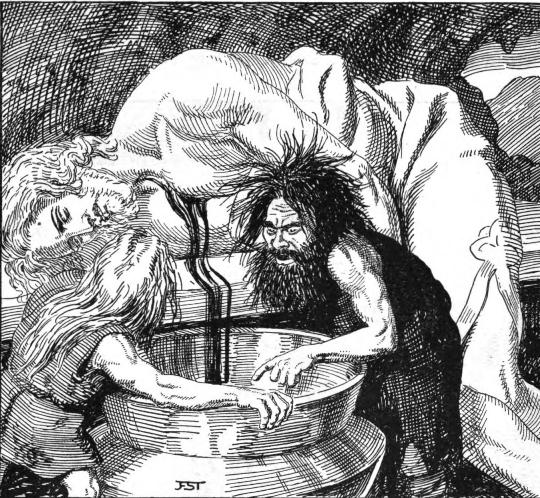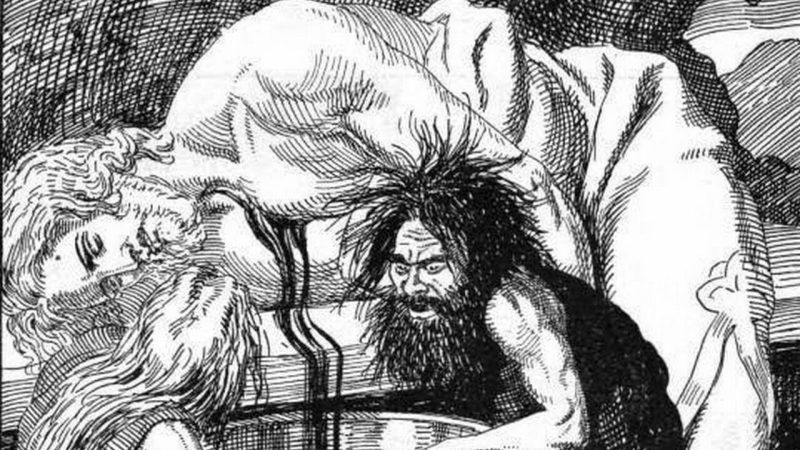Norse mythology says Kvasir was a poet and the wisest man in the nine realms.
He was created when the two warring factions of Asgard and Vanaheim decided to call a truce. The two groups of gods called the Æsir and the Vanir, conducted a peacemaking ritual by all spitting into a cauldron.
Kvasir was born of this saliva and sent to Asgard with the Vanir ruler, Njörd, and his son, Freyr, in return for another wise man, Mímir, and Hoenir going to Vanaheim.
Later, Kvasir was killed by two dwarves who made the mythical mead of poetry from his blood.
What Is Kvasir The God Of?
He is a deity of wisdom, peace, inspiration, and poetry.
Although Kvasir was not a major god, Norse myth considered him the wisest man in the nine worlds.
Is Kvasir Vanir?
Vanir and Æsir spittle created Kvasir, so he is both.
What Does The Word “Kvasir” Mean?
Kvasir is pronounced “kva-seer” with an emphasis on the first syllable.
The word is similar to “kvase” in Norwegian and “kvas” in Russian. Both words mean “fermented berry juice.”
The etymology is unclear. “kvas” probably comes from the Proto-Germanic word “kvass,” which means “to squeeze” or “to crush.” Kvas-ir probably comes from the qualities the gods wished to be present in the fermented berry juice, i.e., wisdom, diplomacy, and inspiration.
Kvasir could also come from the Proto-Indo-European word “kwat” or “fermented drink.”
In Old Norse skaldic poetry, “Kvasis dreyra” (“Kvasir’s blood”) is often used as an adjectival noun phrase, or “kenning,” meaning “poetry.”
Austrian philologist and religious studies scholar Rudolf Simek believes that “kvasir” described fermented berry juice in his dictionary of Northern Mythology.
What Made Kvasir The Wisest Of The Gods?
Kvasir’s intelligence and gift for poetry made him the wisest god.
What Did Kvasir Look Like?
No records exist of a physical description of Kvasir, but in a 1920 illustration called The Dead Kvasir by Franz Stassen, he is depicted as tall and slim with shoulder-length hair and a beard.

Kvasir Attestations
Prose Edda – Gylfaginning
The Binding of Loki and Kvasir
Kvasir is mentioned on one occasion in Chapter 50 of the Prose Edda’s Gylfaginning. The Prose Edda was a collection of Old Norse texts compiled by the Icelandic poet, politician, and historian Snorri Sturluson.
Hár (probably an alias for Odin) tells Gangleri (King Gylfi in disguise) how the trickster god Loki fled to a mountaintop after ruining the reentry of Odin and Frigg’s favorite son, Baldr to the world of the living.
There, he built a house with a door in each of the four walls so he could spot any enemies approaching. Loki knew Odin was looking for him and wondered how he might be caught.
As he often took the form of a salmon and swam near the waterfall Franangrsfors, he reasoned that his hunters might trap him in the water and created an object that would serve as a device for his capture. He wove a net – the first of its kind.
Kvasir finds Loki
Odin found him by searching from Hliðskjálf, Odin’s vantage point and the highest place in the nine realms. When Loki realized this, he threw the net into the fire, fled to Franangrsfors, and transformed into a salmon.
Kvasir, described by Hár as the wisest of all, was among those who entered Loki’s hiding place and saw the net’s remains in the fire’s ashes. Deducing that this net would be used to catch a fish, he told Odin and the hunters to go to the nearest river and look for a fish.
The Allfather caught Loki by the tail and imprisoned him, in human form, in a cave until he was prophecized to free himself before Ragnarök.
Kvasir’s Travels And Death
Fjalar And Galar And The Mead of Poetry
The story of the death of Kvasir appears in the Braga Raedur (“Conversations of Bragi”) from the Skáldskaparmál in the Prose Edda.
Kvasir lived as a wanderer, spreading his wisdom throughout the nine realms. One day, he met two evil dwarfs called Fjalar (“Deceiver”) and Galar “Screamer”).
The couple wanted Kvasir’s blood for their own, so they killed him, added honey to it, and created the mead of poetry.
They stored the mead in two vats called Boðn and Són and a cauldron, Óðrerir (or Óðrœrir). Drinking this mead gave wisdom and the gift of skaldship: the ability to compose the complex and sophisticated Skaldic poetry.
The dwarfs had also killed the parents of a giant called Suttungr (or Suttung), and he, seeking revenge, trapped them on a reef during a low tide. As they faced death by drowning, the dwarfs offered him the mead of poetry in return for their lives.
Odin’s Quest
Odin obtained the magical mead when he charmed the giant’s sister, Gunnlod (or Gunnlǫð), whom Suttungr had entrusted with watching over the three vessels. A disguised Odin had worked for Suttungr’s brother Baugi and had managed to find a way inside the mountain where Baugi stored the mead.
Odin transformed himself into a snake to enter her chamber, took human form, and seduced her. Odin convinced her to allow him a drink of mead for every time he slept with her. After the third time, he drained all three vessels.
Storing the contents in his mouth, he took the form of an eagle and carried the mead back to Asgard.
Suttungr saw what had happened and also transformed into an eagle to give chase. The people of Asgard saw the eagle approaching and laid out several containers for Odin to fill with the mead. Odin spat the contents into the vessels but missed with a few drops which fell onto Midgard.
Whomever the mead fell onto received the gift of poetry. Some accounts state the dark red liquid also fell onto crops, staining them and creating the first beetroot!
Aftermath
The god Aegir explains that the skald poet Bragi told him all about the murder of Kvasir. Consequently, Fjalar and Galar were later tried and found guilty of the crime.
Heimskringla
A euhemerized description of Kvasir appears in chapter 4 of the Ynglinga Saga, part of Heimskringla, a collection of sagas about Swedish and Norwegian kings. He is mentioned as the wisest Vanir.
Vellekla
The kenning expression “Kvasir’s blood,” meaning “poetry,” appears in Vellekla by the 10th-century Icelandic skald Einarr Skálaglamm.

